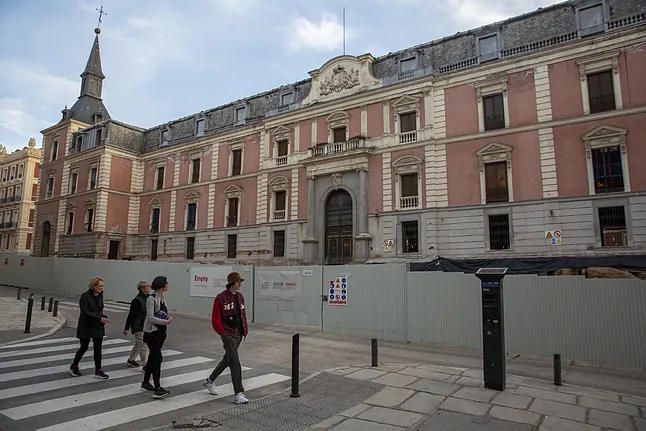The renovation of the Salón de Reinos of the Prado Museum continues to add months to its reopening date. The delay in the works, mainly caused by the discovery of archaeological remains during the adaptation works, means that they will not be completed until at least the second semester of 2026. And, as acknowledged by the artistic institution itself, the opening to the public of this building is still planned for a year later. That is, for the second semester of 2027.
This is stated in the explanatory memorandum of one of the contracts approved by the museum's management last December to carry out these renovations, which involve the alarm station of the Casón del Buen Retiro, which will also serve the Salón de Reinos, and which was published yesterday in the Official State Gazette. The art gallery has confirmed to EL MUNDO that these are the deadlines currently being considered for the presence of the public in the new rooms, six years later than the initial forecast set after its acquisition.
This would extend the complete process to 12 years from when the Prado Museum acquired this space until a hypothetical inauguration. It was in October 2015, still under the government of Mariano Rajoy and with Íñigo Méndez de Vigo as minister, when Culture sealed the transfer of the former building of the Army Museum in favor of the art gallery. A year later, it was announced that the rehabilitation would be carried out by Norman Foster and Carlos Rubio with the intention that by 2019, the bicentennial year of the art center, it could be integrated into the campus.
The inauguration was scheduled for 2021, but the political climate of the change in government due to the motion of censure and the inability of Rajoy's government in its final stage to agree on a budget with Ciudadanos kept delaying that deadline. The year 2024 became the new date for the Salón de Reinos, closed since 2010, to be fully incorporated into the Prado campus and open its doors. However, until July 28, 2022, the works did not begin and the set deadline was then 30 months. This would have meant that it would be presented to the public at the beginning of 2025.
That date was also not met. The archaeological remains found during the works continued to delay the deadlines. In fact, last February, the Council of Ministers was forced to approve the adjustment of the museum's investment budget limits. This adjustment meant an additional cost of 11 million euros for the rehabilitation of the Salón de Reinos and the estimated delay in the works was 18 months beyond the latest plans.
Last week, during the presentation of the Prado Museum's 2025 season, its director, Miguel Falomir, avoided giving a specific date for the reopening of those rooms or what the artistic plans to be followed in them were. However, the center's director did emphasize the importance that this expansion currently has for the art gallery: in the same memorandum that establishes 2027 as the start date of the project, it is detailed that the rehabilitation of the Salón de Reinos is "the main strategic objective" to address for the future of the public institution.
This is due, first of all, to the need for expansion of the Prado to incorporate the 9,000 square meters of the Salón de Reinos, where new exhibitions will be developed. Especially at a time when the number of visitors has been steadily increasing in recent years. In December 2023, the museum announced a historic record of visitors with 3,241,263 people visiting its facilities in the center of Madrid. This scenario has been repeated in the last year. Three weeks ago, the art gallery announced that in the last 12 months it had received 3,258,328 visitors, almost 20,000 more than in the previous period.
To maintain these visit numbers, the Prado Museum presented last Thursday its temporary exhibition season with some of the great names of Western art from recent centuries as the main attraction. El Greco will be the first of them starting on February 18 with all his paintings projected for the Santo Domingo el Antiguo monastery in Toledo. With the exception of one belonging to the Hermitage in St. Petersburg and therefore under the embargo decreed by the European Union for cultural assets from Russia due to Putin's invasion of Ukraine.
